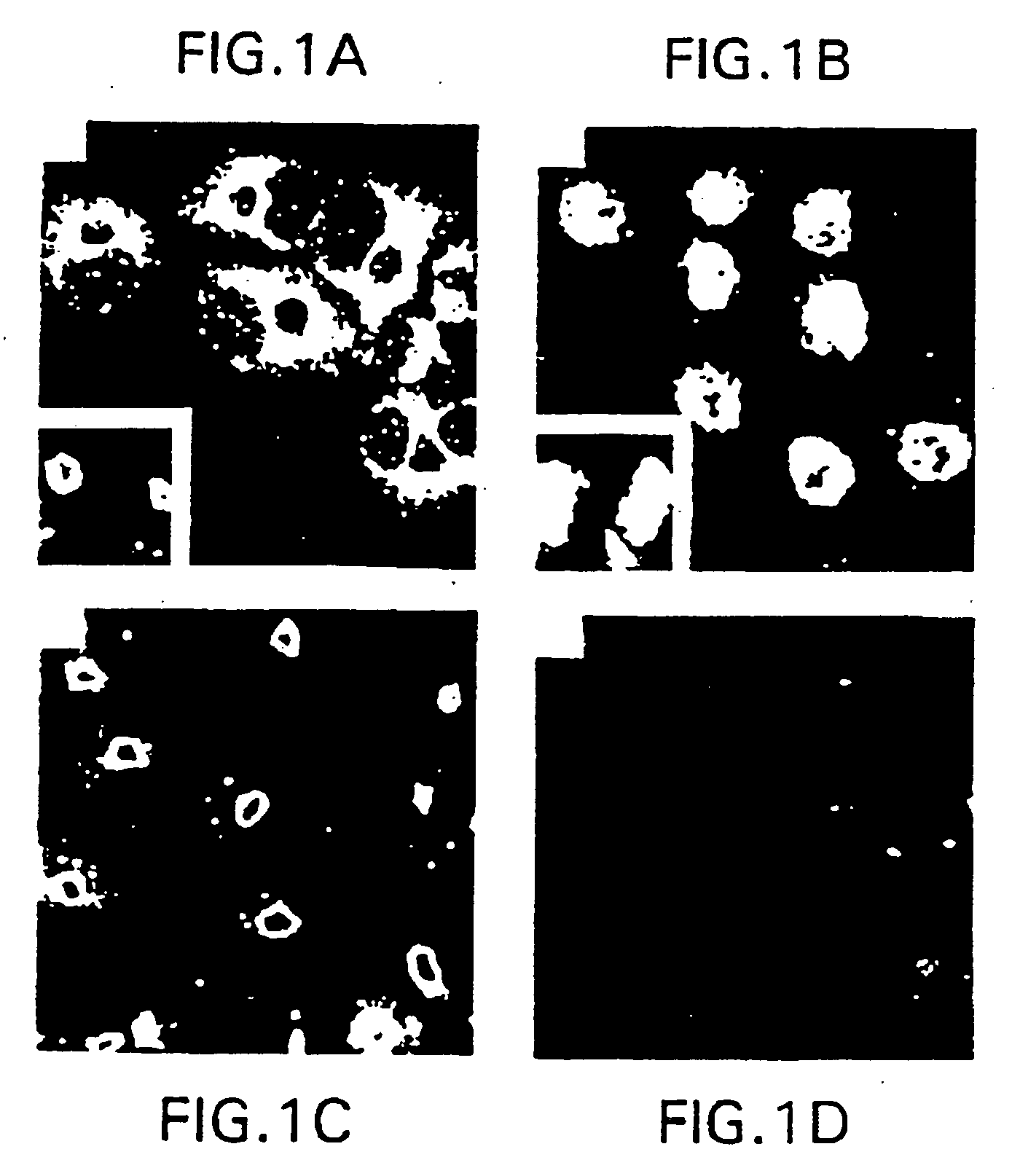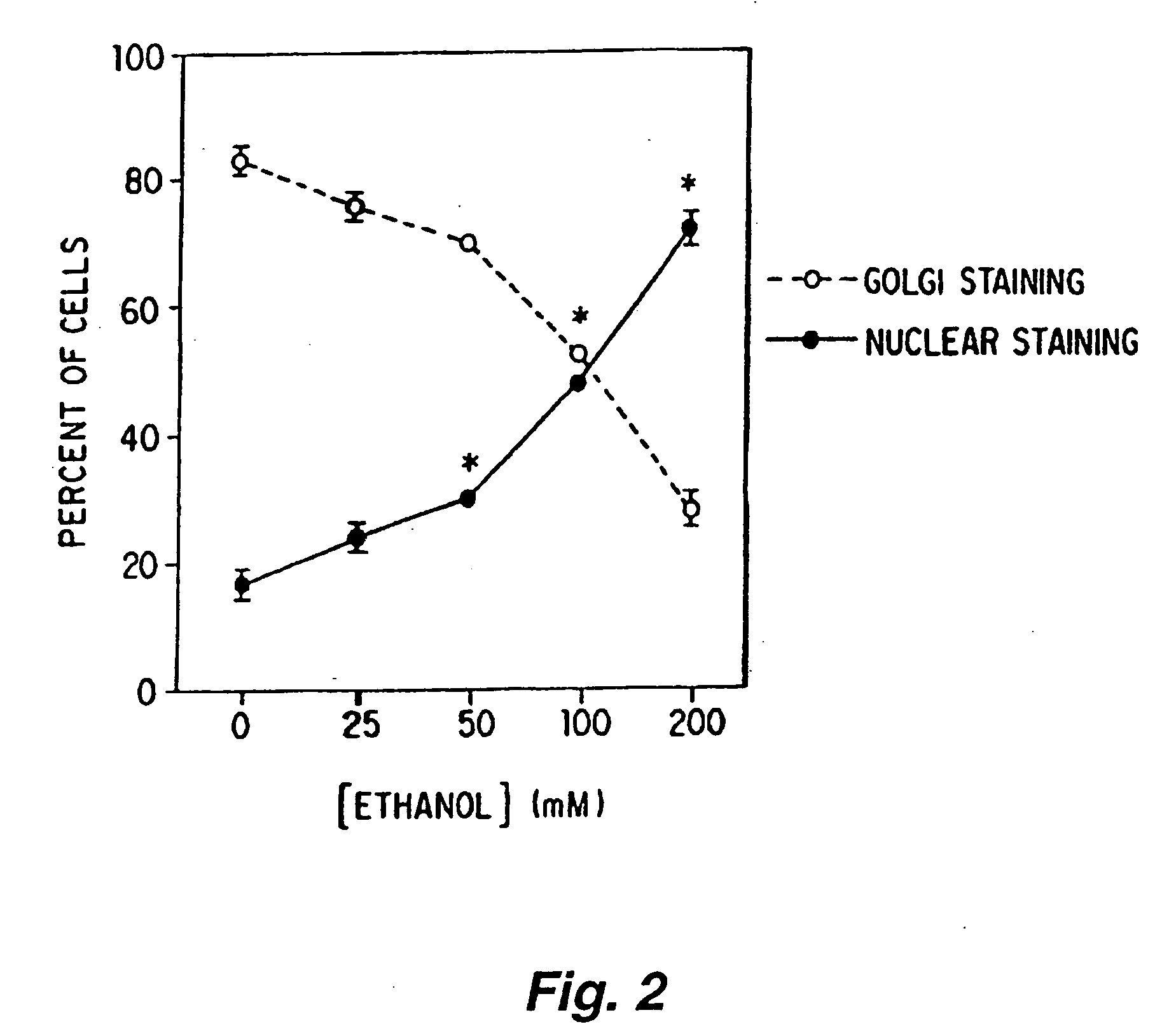Synergy of dopamine d2 and adenosine a2 receptors activates pka signaling via beta/gamma dimers
- Summary
- Abstract
- Description
- Claims
- Application Information
AI Technical Summary
Benefits of technology
Problems solved by technology
Method used
Image
Examples
example 1
Ethanol Induced Translocation of the Cα Catalytic Subunit of PKA
[0301]NG108-15 cells were plated onto single chamber slides in a defined medium at a density of approximately 40,000 cells / slide. The techniques and media used for growing the cells are not critical, and are known to those skilled in the art. Suitable techniques are described in Gordon et al, 1986, Proc. Natl. Acad. Sci. USA 83:2105. The cells were maintained for an additional forty eight (48) hours in the defined media or the defined media containing various concentrations of ethanol (e.g., 25, 50, 100, 200 mM ethanol). The media were replaced by fresh media (with or without ethanol) daily and the slides were wrapped in parafilm to prevent ethanol evaporation. The cells were fixed with methanol on a cooled surface for two (2) to three (3) minutes, and the slides were then immersed twice for five (5) minutes each in phosphate buffered saline (PBS) on ice. After that, the cells were incubated with blocking buffer (1% nor...
example 2
Ethanol Induced Translocation of δ-PKC and ε-PKC
[0320]Immunohistochemistry of δ-PKC in NG108-15 cells, grown in defined medium, shows predominant Golgi staining (FIG. 6); approximately 70% of these cells show Golgi staining (Table 2). After 48 hours ethanol exposure (200 mM EtOH), δ-PKC is localized to the perinucleus and nucleus and absent from the Golgi (FIG. 6 and FIG. 7). More than 90% of the cells show perinuclear and nuclear staining (Table 2). The specificity of the fluorescence staining for δ-PKC is indicated by the absence of staining when the anti-5 antibody is preabsorbed with the immunizing peptide before labeling of the cells (FIG. 7). These results suggest that ethanol exposure causes translocation of δ-PKC from the Golgi to the perinucleus and nucleus since there is little δ-PKC remaining in the Golgi area (Table 2) after ethanol exposure.
[0321]Ethanol also alters localization of ε-PKC. In naive cells, e —PKC is localized to the perinucleus in more than 90% of the cel...
example 3
Altered Localization of PKA Subunits in Lymphocytes and Neutrophils Exposed to Ethanol in Vitro
[0324]Non-alcoholic controls and chronic alcoholics completed an ICD10 questionnaire (a standard means for diagnosis of alcoholism) and were interviewed about their lifetime alcohol consumption. A blank questionnaire is provided in Table 3. Subjects who used other addictive drugs were excluded from the study. Blood alcohol levels were measured at the time of sampling using Alco-screen dipsticks. Routine CBC, triglyceride levels and liver function tests were carried out by the Clinical Hematology Laboratory at San Francisco General Hospital.
TABLE 3Alcohol Dependence Questionnaire.Have you experienced any of the following more than twice in the past year:Compulsion 1)Had a strong desire or urge to drinkYesNo 2)Felt powerless over your drinkingYesNo 3)Needed a drink so badly you couldn't think of anything elseYesNoImpaired Control 4)Tried to cut down or stop drinking and found you couldn't do...
PUM
| Property | Measurement | Unit |
|---|---|---|
| Fraction | aaaaa | aaaaa |
| Fraction | aaaaa | aaaaa |
| Fraction | aaaaa | aaaaa |
Abstract
Description
Claims
Application Information
 Login to View More
Login to View More - R&D
- Intellectual Property
- Life Sciences
- Materials
- Tech Scout
- Unparalleled Data Quality
- Higher Quality Content
- 60% Fewer Hallucinations
Browse by: Latest US Patents, China's latest patents, Technical Efficacy Thesaurus, Application Domain, Technology Topic, Popular Technical Reports.
© 2025 PatSnap. All rights reserved.Legal|Privacy policy|Modern Slavery Act Transparency Statement|Sitemap|About US| Contact US: help@patsnap.com



